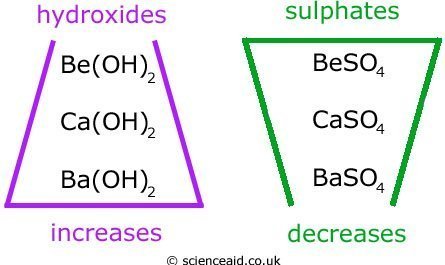

You get less precipitate as you go down the Group because more of the hydroxide dissolves in the water. The calcium hydroxide formed shows up mainly as a white precipitate (although some does dissolve). The hydroxides aren't very soluble, but they get more soluble as you go down the Group. The equation for the reactions of any of these metals would be: Bubbles of hydrogen gas are given off, and a white precipitate (of calcium hydroxide) is formed, together with an alkaline solution (also of calcium hydroxide - calcium hydroxide is slightly soluble). Strontium and barium have reactivities similar to lithium in Group 1 of the Periodic Table.Ĭalcium, for example, reacts fairly vigorously with cold water in an exothermic reaction. These all react with cold water with increasing vigour to give the metal hydroxide and hydrogen. This is because the metal hydroxides thermally decompose (split up on heating) to give the oxide and water. If it reacts with steam, the metal oxide is formed. Note: As a general rule, if a metal reacts with cold water, you get the metal hydroxide. However, the reaction soon stops because the magnesium hydroxide formed is almost insoluble in water and forms a barrier on the magnesium preventing further reaction. After several minutes, some bubbles of hydrogen form on its surface, and the coil of magnesium ribbon usually floats to the surface. Very clean magnesium ribbon has a very slight reaction with cold water. Magnesium burns in steam to produce white magnesium oxide and hydrogen gas. That means that textbook (or these days, web) statements about it never get checked, and are just passed on regardless of their accuracy. This means that few teachers will ever have handled it - I certainly haven't. I think the problem is that beryllium is both expensive and carries major health risks. However, a researcher in the development of nuclear fusion pointed out to me that a lot of work is being done on the reaction between beryllium and steam because it could be a safety issue in reactor design, and sent me a photo showing the result of exposing beryllium to steam at 800☌. Note: Until November 2016, at this point I had the statement: "Beryllium has no reaction with water or steam even at red heat." This was commonly quoted in textbooks, and my sources were a degree level inorganic book, and a later A level inorganic book. (Equation just like the magnesium one below.) It uses these reactions to explore the trend in reactivity in Group 2.īeryllium reacts with steam at high temperatures (typically around 700☌ or more) to give white beryllium oxide and hydrogen. This page looks at the reactions of the Group 2 elements - beryllium, magnesium, calcium, strontium and barium - with water (or steam). REACTIONS OF THE GROUP 2 ELEMENTS WITH WATER

Reactions of the Group 2 elements with water


 0 kommentar(er)
0 kommentar(er)
